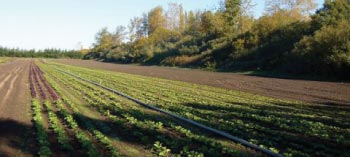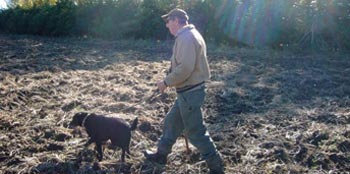Life in the margins
by Stephen Tan
This article was originally published in February 2009

(February 2009) — On the Willits farm in Washington’s Dungeness Valley, marsh, scrub and swaths of blue wildrye and soft rush fill the margins between fields of beets, carrots and kale. Groves of hawthorn trees and low brush rise like islands from the fields. Willows and red alders line the banks of the irrigation canal that traverses the property.
Despite appearances, this environment is largely the result of human effort. John Willits planted his willows and the windbreaks that guard the limits of his beet field. He dug his pond, broadened the margins between his fields, and let them go wild.
Not long ago, some might have questioned the wisdom of surrendering productive farmland. But on this farm and others where efforts have been made to reconnect the land with local ecosystems, what might appear a sacrifice has proven to be anything but.
Since the seeds of wild grasses first were interred with a purpose some 10,000 years ago, farmers have farmed with the land. They planted crops where ecological conditions favored them.

They preserved natural meadows for pasturing livestock, maintained ponds for water, and left rows or ribbons of trees for windbreaks and shade. Often they left land undisturbed simply because the terrain proved too difficult to cut, clear or grade, or the soil too poor to support a crop.
With the industrial age, that changed. Machines, irrigation systems, and chemical herbicides and fertilizers supplied the tools necessary to cultivate areas once too vast to manage and to subdue land once thought unusable. Agricultural policies adopted in the early 1970s, including subsidies based on acreage planted, further rewarded size and efficiency. Farming “fence row to fence row” became the norm.
These changes erased countless acres of farm borders and field edges from the American landscape. What margins remained often fell victim to “farm hygiene,” the practice of removing vegetation around field perimeters for weed control and a tidier appearance.
As the adverse environmental consequences of this way of farming unfolded over time, farmers were encouraged to integrate their land into local ecosystems. Restoring vegetation around fields helps prevent soils from eroding and agricultural chemicals from running off into nearby streams.
Using native plants in these conservation buffers promotes the natural cycling of nutrients and restores biotic regulation, the ecological partnership between plants and soil so critical to keeping land fertile.
Native vegetation also offers protection against colonization by exotic species. Here in the Pacific Northwest, reintroducing spiked bentgrass, wildrye and Western fescue has been shown to inhibit the germination and growth of Scotch broom, reed canary grass and other nonnative species.
Rehabilitating field edges also benefits wildlife. Farmsteads and cropland in the lower 48 states occupy 450 million acres, a quarter of the total landmass and more than four times the combined acreage of all wildlife refuges, primitive areas, wilderness and state and national parks.
Hedgerows between fields create habitat for birds, small mammals and insects. Windbreaks connect larger areas set aside for conservation but fragmented by development. Restored streamside habitats known as riparian zones link high country to lowlands and serve as migration corridors for wildlife.
The benefits of such measures are now so widely understood that government agencies and private groups reward those who take them. Through several conservation initiatives, the U.S. Department of Agriculture subsidizes projects to convert marginal cropland to natural grassland or wetland habitat.
The Washington Department of Ecology offers training on pasture management and streamside planting. The Salmon-Safe program administered by the nonprofit Stewardship Partners provides certification and marketing resources to farmers who rehabilitate riparian zones and plant cover crops in fallow fields to prevent soil erosion.
Financial incentives aside, conservation efforts benefit farmers through reduced operational costs and improved pest control and pollination. An estimated 30 to 40 percent of crops worldwide are lost to pests before harvest.
Local populations of such insects as cucumber beetles, June bugs and leafhoppers can be suppressed significantly by bats drawn to specially designed houses placed in wooded or protected areas. Uncropped grasslands along fence lines, sometimes called “beetle banks,” offer a home to hoverflies, ladybugs, lacewings, parasitic wasps, carabid beetles, assassin bugs and other beneficial insects that prey on pests, costing farmers billions of dollars in annual losses.
Edge habitats also support wild bees. Despite significant declines, the 3,500 species of digger, leafcutter, carpenter, mason and other bees native to North America pollinate crops in the United States valued at $2 to $3 billion annually. With the collapse of European honeybee colonies and a third of U.S. food crops requiring pollination by insects, these native species can help fill what has become a vital need.
Metrics and margins
The benefits of integrating farms into native ecosystems may be widely known, but a contrary movement is taking hold in California’s Central Valley, where virtually all of the country’s commercially produced leafy greens are grown.
In September 2006, spinach contaminated with a virulent strain of bacteria, E. coli O157:H7, killed three people and sickened hundreds of others. Although neither the U.S. Food and Drug Administration nor the California Department of Health Services could determine the source of the contamination, the produce industry reacted swiftly.
By early 2007, the Western Growers Association (WGA), the nation’s largest agricultural trade association, had developed a marketing agreement requiring produce handlers (companies that move produce from farm to market) to accept leafy greens only from growers who adopt certain practices. Those practices are detailed in the Commodity Specific Food Safety Guidelines for the Production and Harvest of Lettuce and Leafy Greens and commonly are referred to as the “Metrics.”
The Metrics assume that isolating cropland from wildlife and wild areas will make food safer. They call for farmers to dismantle conservation buffers, remove trees in riparian zones and windbreaks, fill ponds, drain wetlands, fence fields, install trapping and poisoned bait stations, and scrape their field margins bare of vegetation.
Handlers of more than 99 percent of the nation’s commercially grown leafy greens have signed on to WGA’s marketing agreement. Eager to show how serious they are about reducing risk, some handlers have devised their own “Super Metrics,” which mandate even higher fences, bare earth buffers of several hundred feet, and more extreme efforts to eliminate nearby natural habitat.
To maintain access to the market, farmers have had little choice but to meet these new requirements. Nearly 90 percent of those responding to a recent Monterey County survey acknowledged having taken action to comply. But these growers also are wary about the call for increasingly radical measures to detach their farms from the natural environment.
Proponents of these measures use language that suggests both grave risk and scientific rigor. Wildlife is a “disease vector.” Natural habitat is “harborage.” Even the term “Metrics” implies that the benefits of isolating farms from surrounding ecosystems have been verified empirically.
Yet science offers little evidence that these “ecological sacrifice zones” make produce safer. Studies confirm that cattle and certain wildlife species associated with humans harbor E. coli 0157. They fail to show, however, that pastoral wildlife species (those associated with natural environments) pose a similar threat.
Several recent studies reveal that deer, pastoral birds and small mammals usually do not carry this particular strain. No E. coli 0157 was found in 300 rodent samples taken on farms in the Pacific Northwest.
Wherever pathogens originate, removing conservation buffers and other natural features may do more harm than good. Studies conducted since 2003 reveal that wetlands neutralize infectious agents through numerous physical, chemical and biological pathways; that grassland buffers reduce pathogens in field runoff; and that removing such features as hedgerows and restored riparian habitat actually could elevate the risk of crop contamination.
The push to sever cropland from the natural environment seems driven more by public relations than scientific merit. If so, the relatively harmless practice of keeping fields well-groomed in the interest of farm hygiene is in danger of evolving into a campaign for farm sterilization, a notion so unnatural it should concern us all.
Farms belonging where they are
By the mid-1970s, writer and farmer Wendell Berry had grown uneasy over the increasing disconnectedness between American farms and the land they occupy.
Believing an element of wildness to be fundamental to any enduring agriculture, he urged farmers “to accommodate the margin within the form, to allow the wilderness or nature to thrive in domesticity, to accommodate diversity within unity.” Increasingly extreme, unproven measures imposed in the name of food safety threaten what progress has been made by those striving to heed this advice.
Still, there is reason for hope. Farmers around the world are realizing the benefits of eliminating rather than erecting barriers between their land and the surrounding natural environment.
Some farming operations have been modeled on the very ecosystems they replaced. The discovery in Japan that Aigamo ducks released into rice paddies strengthen root systems and boost yields has transformed rice farming in Southeast Asia.
Brazilian cattle ranchers mimic natural ecosystem succession through perennial grain and grazing rotations that preserve soil health without need for chemical fertilizers. In Ethiopia, coffee farmers are returning to traditional methods of growing their trees in the shade of a forest canopy, a practice that requires no pesticides or herbicides and results in a more flavorful bean.
John Willits doesn’t know whether the wildness his efforts have brought to his farm has improved the quality or yield of the produce grown there. He’s content to wander his margins, watching for the red-tailed hawks that patrol his fields.
John admits to moments of disappointment that owls and a colony of yellowjackets have taken up residence in the nest boxes he put up for wood ducks. But, he knows, such is the nature of wildness. These creatures belong where they are, just as his farm belongs to this land.
Stephen Tan practices environmental law in the Seattle office of the Cascadia Law Group and chairs the PCC Board of Trustees.
